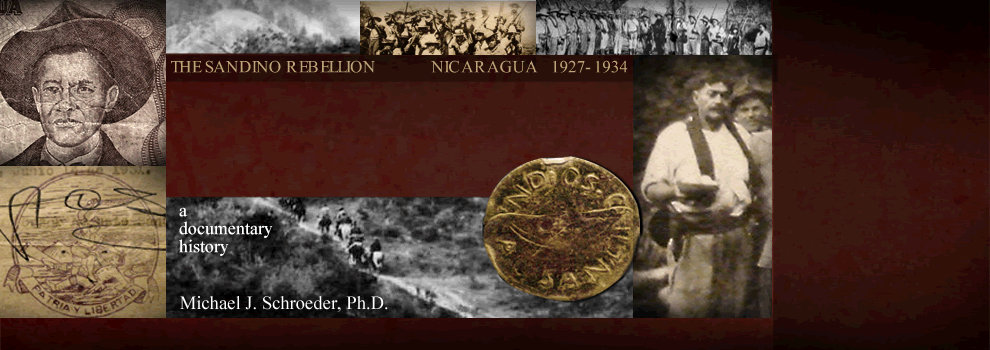|
SECOND BRIGADE MARINE CORPS
MANAGUA, NICARAGUA
12 FEBRUARY, 1929
B-2
REPORT:
/ p. 2 / ... Letter fr. Jefe Politico, Jinotega
containing statement made by Rogelio R. Mangas,
deserter fr. Sandino. ...
/ p. 5 / ... Following is the substance of the
information furnished by a deserter from
Altamirano's force who had been with Sandino and
his force for almost a year.
"Altamirano had 50 men, all but 10 of them
armed, and 1 Lewis gun. Equipment of Sandinistas
consists of:
ARMS. --
2
Browning auto. rifles.
2
Lewis machine guns.
1
Thompson sub-machine gun.
All
except about 50 bandits are armed with rifles.
Others are machete men.
Plenty of pistols and pistol ammunition secured
from Honduras.
Rifle ammunition scarce -- 5 to 50 rounds per
man.
Has
more ammunition for machine guns than for
anything else.
This
is greatest number of arms informant has ever
seen and was at time of concentration in La Luz
near Oconguas in the last days of December,
1928.
No
hidden supply of ammunition.
CLOTHES. --
Men
poorly clad and depend upon raids to provide
clothes.
FOOD. --
Scarce and consists mostly of tortillas and
fresh meat. At one time lived on corn for an
entire month. Many men were sick then but
Sandino has not been sick. No chickens. ...
/
p. 7 / ... The following information relative to
operations and tactics of bandits was furnished
by a deserter from Altamirano's band, who has
been with Sandino's forces for almost a year:
"Tactics of Sandino:
Never remains longer than five days in one
place.
Constantly on the move, in the Jalapa, Poteca,
Fronteras area.
Sandino has never been in contact with Marines
and usually remains some distance from his main
force.
Guardias Civicas are used by Sandino to spy on
his chiefs and bring him information.
Sandino sleeps in houses when possible, but at a
point distant and usually below his main body.
Never travels with more than fifty men.
Never enters towns.
Never disguises himself.
Seldom sees his wife. Never has more than one
woman at a time and is very kind to women, and
punishes with death any follower who assaults a
woman.
Sandino wears boots, dark green breeches and
wool shirt of same color, Stetson hat and a .44
Special revolver with wooden grips.
He kills conservatives and pretends to like
Moncada.
Calls all of Nueva Segovia "El Chupon" and is
usually in the vicinity of a place called "La
Luz."
Never pays his followers but arms them and
endeavors to send them on missions where they
can secure loot.
All of his jefes discussed advisability of
quitting. Sandino said he would take them all
out with him by boat when the time comes for
quitting.
Sandino never intended going to East Coast. / p.
8 /
Sandino said he would never go back to Chipote.
Sandino told all groups to quit using horses
because Aviation was enabled to spot them easily
and horses could not be gotten thru brush
quickly.
On ordinary marches and when Marines are known
to be at some distance bandits march in single
file well closed up and cross open spaces on the
double. When in presence of Marines they march
with about 2 spaces between men. Usually travel
with two men as point, then at 100 yards
distance comes chief with staff, and then at 100
yards follows the main body. When Marines are
near a shot is fired to give the alarm.
Patrols start on day's march at about five and
never later than seven in the morning. Camp
about 2:00 p.m. Camps are temporary structures
built on side of hills near top with sentries on
top of hill.
Sandino camps in valley in extremely dense woods
where it is never very light and where it is
dark by 4:00 p.m. Occasionally camp in caves.
Patrols travel by day or on moonlight nights.
Seldom move on dark nights or when it is
raining.
Sandino dislikes dogs and does not use them for
guards.
Patrols when leaving a trail leave it
individually at different points and re-route at
some point on the new trail. They are very much
afraid of planes and scatter when planes
approach. Always try to find a big tree to get
under.
Dynamite is plentiful.
All handbills were received. Many would quite if
properly informed of treatment to be accorded
them. They were told not to believe the
handbills.
Altamirano and Diaz will never quit.
Sandino has recently been talking of quitting.
If he quits he will go to Mexico or Colombia
where he is getting most of his help. May turn
in arms in some other country but never here.
His secretary at present is A. Marti [Augustin
Faribundo Marti], a Salvadoran.
No white men now with him." ...
/ p. 9 / ... Rogelio Mangas deserted
Altamirano's band on 15 January and surrendered
to the Jefe Politico in Jinotega. ...
[ Summary assessment of the last two weeks'
intelligence by Major Hans Schmidt: ]
/ p. 9 / ... Altamirano and his followers will,
I believe, hold out in banditry longer than any
of the other groups. ... / p. 12 / ... The
efforts of those concerned in the
Jinotega-Matagalpa area should be directed
towards eliminating Altamirano. Altamirano is,
and always has been a real criminal and he
should receive our serious consideration at all
times. Personally I believe him to be more
dangerous to the establishment of a complete
peace in Nicaragua than any other single leader.
A great many bandits may be expected to quit if
Sandino does, but Altamirano will most surely
stay in the field until he is captured or
killed. ...
H.
SCHMIDT
Major, USMC
B-2 ...
RG127/43A/4
Rogelio Mangas listed in Notebook Captured by
Edson from Abraham Rivera, EDSN28.08.19
|

